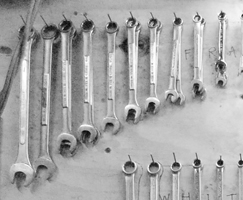The movement of manufacturing out East is often seen as unstoppable. Al Dean goes in search of a locally made home office, (re) learns that history repeats itself and thinks that isn’t always a bad thing
It’s time to confess. I’ve been slacking as the editor-in-chief for the last month or so.
Apart from a lack of travel, partly due to losing my passport somewhere between San Francico and Amsterdam, I’ve been planning out a new office. Many of DEVELOP3D’s team are home workers.
Or rather, Greg works in the park or a coffee shop, Tanya works in her back bedroom and grumbles at the neighbour’s dogs, while Martyn does odd things in a basement in Oxford.
I feel for Mart the most. My own home office has been in a converted cellar for the last ten years and, frankly, a lack of natural daylight, a chilly atomosphere and an olympic standard collection of cardboard boxes has led me to hanker after something lighter, airier and preferably above ground.
Spanner arrangement (courtesy of Cicero Deguzman Jr. – www.godspeed4506.com)
Part of the excitement of an outside office space was the idea of being able to specify my own building size and features to suit my needs. The idea was to have half office, with all the usual luxuries of desk, chair, tea pot and kettle, and then the other half has a workshop for working on a series of articles we’ve got coming up later this year. A portion of which are going to mean tinkering around with old motorcycle components, laser scanners and 3D printing.
I knew what I wanted, a workbench, a toolboard, probably with the rather anal clips for hanging spanners, wrenches and other tools, all in size order of course. I’d probably also have specific places for each so I can see what I’ve lost or misplaced. So, I went off to the local building manufacturer. Gave Mike at B&T Garden Buildings the sizes, the additional requirements in terms of door positioning, windows and a little bit of extra height. Cost was agreed, a date set for delivery and away I went.
Past meets the future
As I stepped out in the street, I looked up at the building I’d just left. Emblazoned across the front were the words “Pelham Street Works.” It was pretty clear this was part of the building when erected and subsequent owners have left it in place. It was here that the Stevens brothers set-up the Stevens Motor Manufacturing Company some time around the turn of the last century. They built their own bikes under the AJS marque as well as supplying power units to other manufacturers. The depression hit them shortly afterward and meant they had to diversify into screw and rivet manufacturing.
The company, it turns out, continued until the mid 1970s, even getting a few podium places on the Junior TT, when it was acquired by the Norton Villiers Group. A government subsidy saw the company move to Andover in Kent. Today, the AJS marque is still alive and well, family owned, although importing and rebranding Chinese made motorcycles. Which to my mind is a shame, but I guess it’s inevitable for the period.
And your point is?
Here’s the point I’m getting to, albeit in a roundabout fashion. Here I was, looking to use some of the leading edge technology available today – and somewhere to write it up at the same time. What I discovered is that there’s a cyclical nature to design and to the production of things. History tells us that a strong brand can thrive but it’s not always about who’s got the better product, who’s got the leading edge technology. There are often greater forces at play.
The post war period and subsequent economic boom saw western economies move toward a desire for more products, more things and at cheaper prices than ever before. Our own comfort, lack of interest in getting our hands dirty in the business of making things was solved by other countries looking to fill that gap, to build up their own economies by taking on the jobs that the established nations didn’t.
Closing the loop… again?
In this issue you will have found stories of companies looking to manufacture again. To get their hands dirty, to bring their own products to market. Fuel and transportation costs combined with increasing costs of once emerging nations, mean that low labour costs are being offset and the power isn’t in the hands of the factories in the east.
Tanya spoke to Tae of Alite Designs after I was introduced to him by a mutual friend outside a rather delightful bar in San Francisco’s Mission District. He told me of his products and showed me the “sexy hotness sleeping bag” on his phone with the pride of a man that’s living the dream. Stephen visited the team at Swifty and found a company bootstrapping its business and building some very cool, desirable products in the middle of Salford, Manchester.
These are the people we’re interested in, those on the ground, finding an idea, developing a passion and running with it. The people not following convention of outsourcing production and doing it locally, even if their market is global. These are the people that will break the “design here/make here” cycle and change it. Just like the Stevens Brothers did.
Large scale manufacturing will never be the same again, the world has become far too used to cheap goods, to disposable products that end up in landfill just a short time outside of their warranty. But there is a reaction against it. All across the globe, you can find small companies producing amazing products and doing so without following conventional wisdom.
Now. Where’s my angle grinder? I’ve got work to do.

Al Dean contemplates the cyclical nature of design and production
Default







